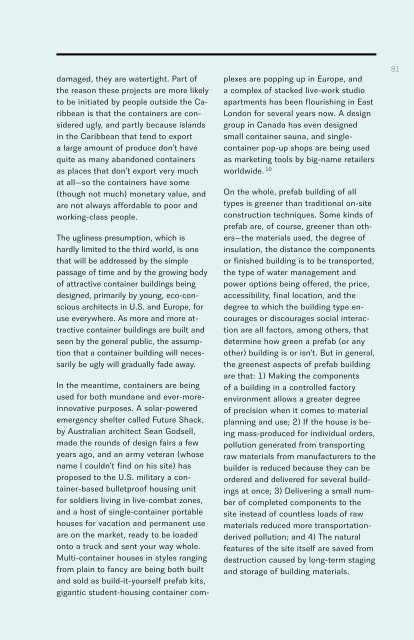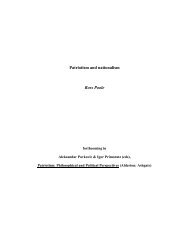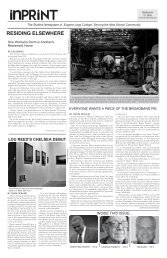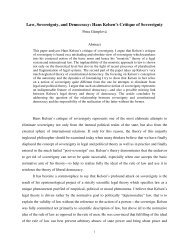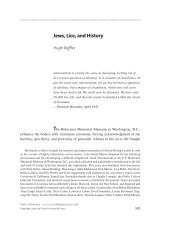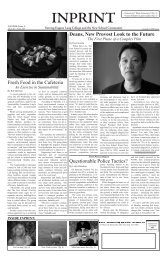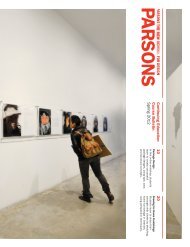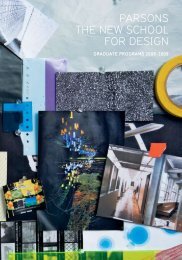PARSONS AAS INTERIOR DESIGN - The New School
PARSONS AAS INTERIOR DESIGN - The New School
PARSONS AAS INTERIOR DESIGN - The New School
You also want an ePaper? Increase the reach of your titles
YUMPU automatically turns print PDFs into web optimized ePapers that Google loves.
damaged, they are watertight. Part of<br />
the reason these projects are more likely<br />
to be initiated by people outside the Caribbean<br />
is that the containers are considered<br />
ugly, and partly because islands<br />
in the Caribbean that tend to export<br />
a large amount of produce don’t have<br />
quite as many abandoned containers<br />
as places that don’t export very much<br />
at all—so the containers have some<br />
(though not much) monetary value, and<br />
are not always affordable to poor and<br />
working-class people.<br />
<strong>The</strong> ugliness presumption, which is<br />
hardly limited to the third world, is one<br />
that will be addressed by the simple<br />
passage of time and by the growing body<br />
of attractive container buildings being<br />
designed, primarily by young, eco-conscious<br />
architects in U.S. and Europe, for<br />
use everywhere. As more and more attractive<br />
container buildings are built and<br />
seen by the general public, the assumption<br />
that a container building will necessarily<br />
be ugly will gradually fade away.<br />
In the meantime, containers are being<br />
used for both mundane and ever-moreinnovative<br />
purposes. A solar-powered<br />
emergency shelter called Future Shack,<br />
by Australian architect Sean Godsell,<br />
made the rounds of design fairs a few<br />
years ago, and an army veteran (whose<br />
name I couldn’t find on his site) has<br />
proposed to the U.S. military a container-based<br />
bulletproof housing unit<br />
for soldiers living in live-combat zones,<br />
and a host of single-container portable<br />
houses for vacation and permanent use<br />
are on the market, ready to be loaded<br />
onto a truck and sent your way whole.<br />
Multi-container houses in styles ranging<br />
from plain to fancy are being both built<br />
and sold as build-it-yourself prefab kits,<br />
gigantic student-housing container com-<br />
plexes are popping up in Europe, and<br />
a complex of stacked live-work studio<br />
apartments has been flourishing in East<br />
London for several years now. A design<br />
group in Canada has even designed<br />
small container sauna, and singlecontainer<br />
pop-up shops are being used<br />
as marketing tools by big-name retailers<br />
worldwide. 10<br />
On the whole, prefab building of all<br />
types is greener than traditional on-site<br />
construction techniques. Some kinds of<br />
prefab are, of course, greener than others—the<br />
materials used, the degree of<br />
insulation, the distance the components<br />
or finished building is to be transported,<br />
the type of water management and<br />
power options being offered, the price,<br />
accessibility, final location, and the<br />
degree to which the building type encourages<br />
or discourages social interaction<br />
are all factors, among others, that<br />
determine how green a prefab (or any<br />
other) building is or isn’t. But in general,<br />
the greenest aspects of prefab building<br />
are that: 1) Making the components<br />
of a building in a controlled factory<br />
environment allows a greater degree<br />
of precision when it comes to material<br />
planning and use; 2) If the house is being<br />
mass-produced for individual orders,<br />
pollution generated from transporting<br />
raw materials from manufacturers to the<br />
builder is reduced because they can be<br />
ordered and delivered for several buildings<br />
at once; 3) Delivering a small number<br />
of completed components to the<br />
site instead of countless loads of raw<br />
materials reduced more transportationderived<br />
pollution; and 4) <strong>The</strong> natural<br />
features of the site itself are saved from<br />
destruction caused by long-term staging<br />
and storage of building materials.<br />
81


